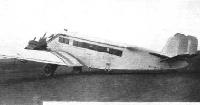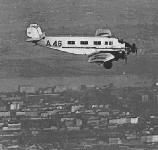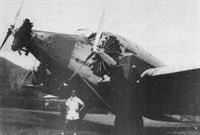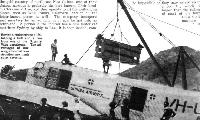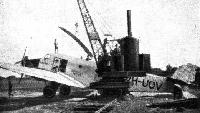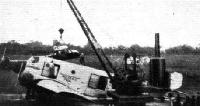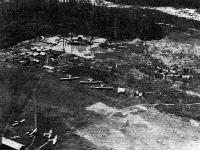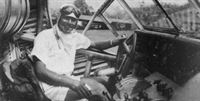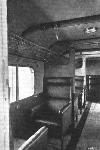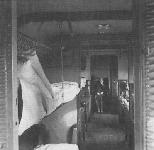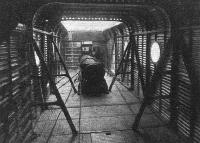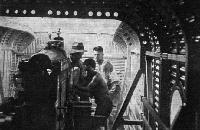
Описание
Страна : Германия
Год : 1926
Пассажирский транспортный самолет с экипажем из четырех человек, способный перевозить 10 пассажиров ночью или 15 - днем
Junkers G.31
Со смягчением ограничений, наложенных на германскую авиапромышленность, у компании "Junkers" появилась возможность разработать и построить большой транспортный самолет. Созданный G 31 коммерческого успеха не имел, но он стал первым пассажирским самолетом, на борту которого появился стюард.
Трехмоторную схему самолета конструкторы выбрали, чтобы обойти ограничения, установленные союзниками, однако она была предпочтительнее одномоторной и с точки зрения безопасности полетов. Большие размеры самолета отражали тенденцию роста авиаперевозок в Европе.
Под общим руководством Эрнста Цинделя полномасштабное проектирование вел инженер Хоффман. G 31 проектировался как моноплан пассажировместимостью 15 человек. В салоне предусмотрели наличие туалета и отдельных купе-отсеков, наклон спинок кресел регулировался. Прототип выполнил первый полет 7 сентября 1926 года с тремя моторами Junkers L2, средний мотор позже заменили на BMW VI.
В 1926-1931 годах построили восемь самолетов для компании "Deutsche Lufthansa": три G 31a с моторами Gnome-Rhone Jupiter VI и двухкилевым оперением и три G 31fi с увеличенными фюзеляжем и крылом и тремя моторами Siemens Jupiter. В 1931-1932 годах построили первые G 31fo с моторами BMW Hornet. На некоторых самолетах "Deutsche Lufthansa" оборудовали кухни для обеспечения пассажиров в полете горячей пищей. G 31 эксплуатировали до 1935 года, потом некоторые машины передали Люфтваффе, где их никогда не применяли на фронте.
Четыре G 31 продали австралийской компании "Guinea Airways", эти самолеты обслуживали месторождения золота на Новой Гвинее. Одним из них был первый прототип, три других - вариант G 31 до с открытой кабиной экипажа и грузовым люком в днище фюзеляжа. Три самолета было уничтожено в 1942 году при авиационном налете, уцелевшая машина получила в австралийских ВВС регистрацию A44-1. В конце 1942 года эта машина получила повреждения, но в 1945 году ее отремонтировали, после чего некоторое время эксплуатировали.
ТАКТИКО-ТЕХНИЧЕСКИЕ ХАРАКТЕРИСТИКИ
Junkers G 31fo
Тип: пассажирский транспортный самолет с экипажем из четырех человек (два пилота, стюард, радист), способный перевозить 10 пассажиров ночью или 15 - днем
Силовая установка: три 9-цилиндровых звездообразных мотора Pratt & Whitney Hornet постройки компании "BMW" мощностью по 525 л. с.
Летные характеристики: макс. скорость 210 км/ч; крейсерская скорость 170 км/ч; максимальная дальность 850 км; продолжительность полета 5 ч; практический потолок 4400 м
Масса: пустого 5250 кг; максимальная взлетная 8500 кг
Размеры: размах крыла 30,50 м; длина 16,50 м; высота 6,00 м; площадь крыла 102,0 м2
Описание:
- Junkers G.31
- Flight, March 1927
NEW JUNKERS COMMERCIAL MONOPLANE - Flight, October 1928
Berlin Aero Show 1928
Фотографии
-
Aeroplane Monthly 1986-03 / J.Stroud - Wings of Peace
The prototype Junkers G 31 in its original form with three Junkers L 5 engines: Although Germany has been released from the restrictions imposed by the Allies for but a very short time, the Junkers Works of Dessau have already completed a new machine of some 100 sq. m. (1,076 sq. ft.) wing area. The width of the fuselage is in the neighbourhood of 10 ft., and below the floor of the saloon is a large space for luggage and goods. The three engines are Junkers, developing a total of more than 1,000 h.p.
-
Aeroplane Monthly 1986-03 / J.Stroud - Wings of Peace
The prototype G 31 with BMW VI nose engine and slimmer cowlings to the wing engines.
-
Aeroplane Monthly 1986-03 / J.Stroud - Wings of Peace
The prototype G 31 with BMW nose engine and full-span ailerons.
-
Aeroplane Monthly 1986-03 / J.Stroud - Wings of Peace
An unidentified but early G 31 with Gnome-Rhone Jupiter engines. This may have been the second G 31.
-
Aeroplane Monthly 1997-06 / H.Amtmann - My Junkers years
Регистрационный номер: A-46 [2] Junkers-G 31de Werknr 3003 serving as A 46 Osterreich of Osterreichische Luftverkehrs AG.
-
Aeroplane Monthly 1986-03 / J.Stroud - Wings of Peace
Регистрационный номер: A-46 [2] Olag’s G 31de A 46 Osterreich over Vienna.
-
Aeroplane Monthly 1986-03 / J.Stroud - Wings of Peace
Регистрационный номер: D-1310 [3] The Jupiter-powered G 31de D-1310 at Croydon. At the time of this picture it was named Deutschland.
-
Мировая Авиация 161
Регистрационный номер: D-1310 [3] Первый G.31, переданный компании "Deutsche Lufthansa", в 1928 году получил собственное имя "Hermann Kohl". На G 31 впервые в мире организовали горячее питание пассажиров, а в состав экипажа ввели стюарда.
Junkers-G 31s of Luft Hansa were often seen plying their trade. This is D-1310, the first of the type delivered to the airline, named Hermann Kohl after the pilot who made the first east-west crossing of the North Atlantic. -
Flight 1928-10 / Flight
The Junkers G.31 has three "Jupiter" engines, of which the central engine is fitted with a four-bladed propeller. This engine is geared, while the wing engines are direct-drive types.
-
Flight 1927-09 / Flight
Регистрационный номер: D-1137 THE ZURICH MEETING: Three-quarter front view of the "Jupiter"-engined Junkers which won the Circuit of the Alps for commercial aeroplanes.
-
Flight 1933-10 / Flight
Регистрационный номер: D-1786 [2] FOR LUFT HANSA NIGHT SERVICE: The Junkers Ju.52.3m. (G 31 ???) which Deutsche Luft Hansa have put into operation on the night service between Berlin and Croydon during the winter.
-
Aeroplane Monthly 1986-03 / J.Stroud - Wings of Peace
Регистрационный номер: D-1786 [2] G 31fo D-1786 Westmark at Schiphol. In the background are AB Aerotransport's G 23 SE-AAE and Luft Hansa’s Fokker F.III D-594.
Другие самолёты на фотографии: Fokker F.III - Нидерланды - 1921Junkers G 23 / G 24 - Германия - 1924
-
Aeroplane Monthly 1986-03 / J.Stroud - Wings of Peace
Регистрационный номер: D-1310 [3] D-1310 H. Kohl as the G 31ho with lengthened fuselage, Pratt & Whitney Hornet nose engine with four-bladed propeller, and two BMW Hornets. Aileron area has been increased.
-
Aeroplane Monthly 1978-12 / Personal album
George Cannon poses with a Junkers G31 at Wau in 1937. Despite their crude-looking corrugated finish and boxy engine nacelles, the G31s were great workhorses. From the time they entered service in April 1931 until August 31, 1936, the three G31s made 5,701 trips, flew 586,147 miles, and carried 15,861 tons and 4,229 passengers.
-
Air Enthusiast 1998-09 / J.Grant - Corrugated Masterpieces
Регистрационный номер: VH-URQ The G.31 prototype, VH-URQ, showing the fuselage of a W.34 (possibly VH-UJD) being lifted through the fuselage hatch.
Другие самолёты на фотографии: Junkers W 33 / W 34 / Ju.46 - Германия - 1926
-
Air Pictorial 1958-08
Регистрационный номер: VH-UOU [7] One of the three Junkers G-31s used during the development of the New Guinea goldfields.
-
Air Enthusiast 1998-09 / J.Grant - Corrugated Masterpieces
Регистрационный номер: VH-UOU [7] Loading a section of gold mining dredge into VH-UOU. Note that the type is shown on the fin as a J.31go, while the designation G.31 appeared on the others.
-
Flight 1930-10 / Flight
Регистрационный номер: VH-UOU [7] A JUNKERS FREIGHT CARRIER FOR NEW GUINEA: A Junkers G.31 monoplane recently supplied to Guinea Airways, Ltd., for the transport of heavy machinery etc. Standing in front of the machine is Mr. A. S. Cross, the company's Chief Pilot.
-
Aeroplane Monthly 1991-07 / T.Gwynn-Jones - Flying for gold (2)
Регистрационный номер: VH-UOU [7] The roof hatch above the Junkers-G' 31’s cavernous cargo bay allowed easy loading of equipment such as this three-ton tube mill. The picture also shows the open-cockpit conversion of the G 31 preferred for the short-haul operations in New Guinea’s torrid conditions.
-
Aeroplane Monthly 1986-03 / J.Stroud - Wings of Peace
Регистрационный номер: VH-UOU [7] Loading a 5,890 lb section of tube mill into G 31 go VH-UOU at Lae.
-
Flight 1936-08 / Flight
Bovine airmindedness: Unloading a bull and a cow from one of the G.31S at Wau aerodrome. The advantages of low-wing all-metal construction are made quite obvious.
-
Flight 1933-12 / Flight
Регистрационный номер: VH-UOV [2] IN NEW GUINEA: One of the Junkers G.31 heavy freight monoplanes (three "Hornets") used by Guinea Airways, Ltd., for transporting mining machinery, etc., to the Bulolo goldfields.
-
Aeroplane Monthly 1991-06 / T.Gwynn-Jones - Flying for gold (1)
Регистрационный номер: VH-UOV [2] At Lae a baby Austin car is loaded aboard a Junkers-G 31 for delivery to Dr Ian Dickson - the goldfield’s resident doctor.
-
Flight 1932-02 / Flight
A Morris-Cowley being transported by a Junkers G.31 to the gold fields in New Guinea.
-
Aeroplane Monthly 1991-07 / T.Gwynn-Jones - Flying for gold (2)
Unloading a car at Wau.
-
Aeroplane Monthly 1991-07 / T.Gwynn-Jones - Flying for gold (2)
At Wau a "Bitza" truck is hoisted out of a G 31. Made from assorted vehicles, the truck had a three-foot wide chassis to negotiate a narrow donkey track between Wau and an isolated mine site.
-
Air Enthusiast 1998-09 / J.Grant - Corrugated Masterpieces
Регистрационный номер: VH-UOW [2] G.31 VH-UOW of Guinea Airways. The top fuselage hatch is lying alongside the aircraft.
-
Aeroplane Monthly 1991-07 / T.Gwynn-Jones - Flying for gold (2)
Unloading a tractor from a Junkers-G 31 at Wau.
-
Aeroplane Monthly 1991-07 / T.Gwynn-Jones - Flying for gold (2)
Looking into the large, practical cargo bay of a Junkers-G 31.
-
Aeroplane Monthly 1986-03 / J.Stroud - Wings of Peace
Регистрационный номер: VH-UOU [7] Bulolo Gold Dredging’s G 31go Paul en route from Lae to Wau.
-
Aeroplane Monthly 1991-07 / T.Gwynn-Jones - Flying for gold (2)
Регистрационный номер: VH-UOW [2] The 1-in-12 slope of the Wau airstrip is clearly apparent.
-
Aeroplane Monthly 1991-07 / T.Gwynn-Jones - Flying for gold (2)
Part of the Guinea Airways fleet at Lae in 1932. In addition to the Junkers-G 31s, a pair of W 34 monoplanes and three D.H.60 Moths are on display.
Другие самолёты на фотографии: De Havilland Gipsy Moth / Moth X - Великобритания - 1928Junkers W 33 / W 34 / Ju.46 - Германия - 1926
-
Jane's All the World Aircraft 1938 / 01 - The progress of the world in civil aviation during the year 1937-38
One of the four Gold Dreggers erected by the Bulolo Gold Dredging Co., New Guinea. Three of the Junkers G-31 monoplanes (Pratt & Whitney "Hornets") which carried in sections up from the coast are in foreground.
-
Flight 1936-08 / Flight
The gold rush: One of the mine landing grounds with the dredge in operation and most of the Guinea Airways' fleet deployed on the field.
-
Aeroplane Monthly 1991-07 / T.Gwynn-Jones - Flying for gold (2)
Bulolo aerodrome on March 21, 1932. The line-up of aircraft brought officials and guests to the party celebrating the completion of No 2 Dredge (the large structure directly above the trio of G 31s at centre left).
-
Aeroplane Monthly 1986-03 / J.Stroud - Wings of Peace
The neatly laid out flight deck of the G 31, showing dual controls, etc.
-
Aeroplane Monthly 1978-12 / Personal album
Another view of the G31 cockpit, showing the central console.
-
Aeroplane Monthly 1978-12 / Personal album
Our contributor in the cockpit of a Junkers G31, New Guinea, 1936. Powered by a trio of Pratt & Whitney Hornet radials, the big G31 could carry a load of 6,000lb.
-
Aeroplane Monthly 1986-03 / J.Stroud - Wings of Peace
Май 1928г.: трехмоторный самолет Junkers G 31 поступил в эксплуатацию в авиакомпанию "Luft Hansa". В этой компании впервые появились стюарды, разносившие в полете еду и напитки.
Cabin service was first provided by Luft Hansa in the G 31. Note the continuous baggage racks passing through the semi-bulkheads. -
Flight 1928-10 / Flight
View inside the cabin of the Junkers G.31.
-
Aeroplane Monthly 1986-03 / J.Stroud - Wings of Peace
COMFORT IN SIZE: The latest type of Junkers aeroplane, the three-engined G.31, has been experimentally equipped with sleeping accommodation, although by a slight rearrangement the saloon can be used for ordinary day travel. One feature is that the available saloon space is sub-divided so that lounge chairs may be provided in one compartment, sleeping berths in another. The view shows the saloon, looking aft from the pilots' cockpit
-
Flight 1927-03 / Flight
The view shows the forward compartment, with the door leading to the cockpit. A large luggage compartment is situated in the bottom of the fuselage, under the floor of the saloon.
-
Flight 1927-08 / Flight
A BRISTOL-ENGINED JUNKERS G.31: The photograph shows a Junkers equipped as a Red Cross machine with eight berths and a chair for the attendant. Presumably, this arrangement might be equally suitable for a night-flying machine.
-
Flight 1930-10 / Flight
"TONS" OF ROOM: The interior of the Junkers G.31 freight carrier supplied to Guinea Airways, Ltd. Note method of anchoring the cargo, and the large hatch in roof.
-
Flight 1936-08 / Flight
Half a ton or so: This photograph gives an idea of the method used for stowing freight in one of the G.A. Junkers it is actually being loaded at Lae for transport to the Bulolo goldfields. The size of the loading hatch is noteworthy.
-
Aeroplane Monthly 1986-03 / J.Stroud - Wings of Peace
Регистрационный номер: VH-UOU [7] Bulolo Gold Dredging's Junkers G 31go Bulolo 1 Paul. It bore the designation J 31go on its fin.
-
Flight 1929-07 / Flight Advertisements
A Luft Hansa Junkers G31, 12-passenger monoplane.
- Фотографии


